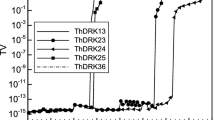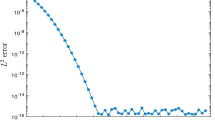Abstract
The Exponential Time Difference Runge–Kutta method (ETDRK) is an important approach for simulating gradient flow models, and whether it can maintain energy stability is an important research topic. New adaptive ETDRK method (ETDRK32) has been designed in [4] and proven to possess the property of long time unconditional energy stability for one specific parameter \(\alpha =\frac{2}{3}\). In this paper, we adopt a new method of semi-positive definite matrix decomposition to prove the long-term energy stability of the schemes when the parameter \(\alpha \) is within a certain range. Furthermore, we provide numerical simulations to verify the theoretical analysis and demonstrate the convergence and energy stability of the new schemes.










Similar content being viewed by others
Data Availability
Data sharing not applicable to this article as no datasets were generated or analysed during the current study.
References
Allen, S.M., Cahn, J.W.: A microscopic theory for antiphase boundary motion and its application to antiphase domain coarsening. Acta Metall. 27(6), 1085–1095 (1979)
Brune, H.: Epitaxial growth of thin films. Surf. Interface Sci. 4, 421–477 (2014)
Cahn, J.W., Hilliard, J.E.: Free energy of a nonuniform system I Interfacial free energy. J. Chem. Phys. 28(2), 258–267 (1958)
Cao, W., Yang, H., Chen, W.: An exponential time differencing Runge-Kutta method ETDRK32 for phase field models. J. Sci. Comput. 99, 6 (2024)
Chen, L.: Phase-field models for microstructure evolution. Annu. Rev. Mater. Res. 32(1), 113–140 (2002)
Chen, W., Li, W., Luo, Z., Wang, C., Wang, X.: A stabilized second order exponential time differencing multistep method for thin film growth model without slope selection. ESAIM: Math. Model. Numer. Anal. 54(3), 727–750 (2020)
Chen, W., Li, W., Wang, C., Wang, S., Wang, X.: Energy stable higher-order linear ETD multi-step methods for gradient flows: application to thin film epitaxy. Res. Math. Sci. 7(3), 1–27 (2020)
Chen, W., Wang, S., Wang, X.: Energy stable arbitrary order ETD-MS method for gradient flows with Lipschitz nonlinearity. CSIAM Trans. Appl. Math. 2(3), 460–483 (2021)
Chen, W., Wang, X., Yan, Y., Zhang, Z.: A second order BDF numerical scheme with variable steps for the Cahn-Hilliard equation. SIAM J. Numer. Anal. 57(1), 495–525 (2019)
Chen, W., Zhang, Y., Li, W., Wang, Y., Yan, Y.: Optimal convergence analysis of a second order scheme for a thin film model without slope selection. J. Sci. Comput. 80(3), 1716–1730 (2019)
Cheng, K., Qiao, Z., Wang, C.: A third order exponential time differencing numerical scheme for no slope-selection epitaxial thin film model with energy stability. J. Sci. Comput. 81(1), 154–185 (2019)
Cheng, Q., Shen, J.: Multiple scalar auxiliary variable (MSAV) approach and its application to the phase field vesicle membrane model. SIAM J. Sci. Comput. 40(6), A3982–A4006 (2018)
Choi, J.W., Lee, H.G., Jeong, D., Kim, J.: An unconditionally gradient stable numerical method for solving the Allen-Cahn equation. Phys. A Stat. Mech. Appl. 388(9), 1791–1803 (2009)
Cox, S.M., Matthews, P.C.: Exponential time differencing for stiff systems. J. Comput. Phys. 176(2), 430–455 (2002)
Du, Q., Ju, L., Li, X., Qiao, Z.: Maximum principle preserving exponential time differencing schemes for the nonlocal Allen-Cahn equation. SIAM J. Numer. Anal. 57(2), 875–898 (2019)
Ehrlich, G., Hudda, F.G.: Atomic view of surface self-diffusion: tungsten on tungsten. J. Chem. Phys. 44(3), 1039–1049 (1966)
Elliott, C.M., Stuart, A.M.: The global dynamics of discrete semilinear parabolic equations. SIAM J. Numer. Anal. 30(6), 1622–1663 (1993)
Eyre, D.J. (1998): Unconditionally gradient stable time marching the Cahn-Hilliard equation. MRS Online Proceedings Library (OPL) 529, 39–46
Fu, Z., Yang, J.: Energy-decreasing exponential time differencing Runge-Kutta methods for phase-field models. J. Comput. Phys. 454, 110943 (2022)
Fu, Z., Shen, J., Yang, J.: Higher-order energy-decreasing exponential time differencing Runge-Kutta methods for gradient flows. arXiv:2402.15142(2024)
Golubović, L.: Interfacial coarsening in epitaxial growth models without slope selection. Phys. Rev. Lett. 78(1), 90–93 (1997)
Hao, Y., Huang, Q., Wang, C.: A third order BDF energy stable linear scheme for the no-slope-selection thin film model. Commun. Comput. Phys. 29(3), 905–929 (2021)
Hochbruck, M., Ostermann, A.: Explicit exponential Runge-Kutta methods for semi-linear parabolic problems. SIAM J. Numer. Anal. 43(5), 1069–1090 (2005)
Hochbruck, M., Ostermann, A.: Exponential integrators. Acta Numerica. 19, 209–286 (2010)
Ju, L., Li, X., Qiao, Z., Zhang, H.: Energy stability and error estimates of exponential time differencing schemes for the epitaxial growth model without slope selection. Math. Comput. 87(312), 1859–1885 (2018)
Kassam, A.K., Trefethen, L.N.: Fourth-order time-stepping for stiff PDEs. SIAM J. Sci. Comput. 26(4), 1214–1233 (2005)
Lebedev, V., Sysoeva, A., Galenko, P.: Unconditionally gradient-stable computational schemes in problems of fast phase transitions. Phys. Rev. E 83(2), 026705 (2011)
Li, W., Chen, W., Wang, C., Yan, Y., He, R.: A second order energy stable linear scheme for a thin film model without slope selection. J. Sci. Comput. 76(3), 1905–1937 (2018)
Li, Y., Lee, H.G., Jeong, D., Kim, J.: An unconditionally stable hybrid numerical method for solving the Allen-Cahn equation. Comput. Math. Appl. 60(6), 1591–1606 (2010)
Liao, H.L., Song, X., Tang, T., Zhou, T.: Analysis of the second-order BDF scheme with variable steps for the molecular beam epitaxial model without slope selection. Sci. China Math. 64(5), 887–902 (2021)
Qiao, Z., Zhang, Z., Tang, T.: An adaptive time-stepping strategy for the molecular beam epitaxy models. SIAM J. Sci. Comput. 33(3), 1395–1414 (2011)
Shen, J., Jie, X., Yang, J.: The scalar auxiliary variable (SAV) approach for gradient flows. J. Comput. Phys. 353, 407–416 (2018)
Tourret, Damien, Liu, Hong, Lorca, Javier: Phase-field modeling of microstructure evolution: recent applications, perspectives and challenges. Prog. Mater. Sci. 123, 100810 (2002)
Wang, C., Wang, X., Wise, S.M.: Unconditionally stable schemes for equations of thin film epitaxy. Discrete Contin. Dyn. Syst. 28(1), 405–423 (2010)
Yang, X.: Linear, first and second-order, unconditionally energy stable numerical schemes for the phase field model of homopolymer blends. J. Comput. Phys. 327, 294–316 (2016)
Yang, X., Zhao, J., Wang, Q., Shen, J.: Numerical approximations for a three-component Cahn-Hilliard phase-field model based on the invariant energy quadratization method. Math. Mod. Methods Appl. Sci. 27(11), 1993–2030 (2017)
Zhang, Z., Qiao, Z.: An adaptive time-stepping strategy for the Cahn-Hilliard equation. Commun. Comput. Phys. 11(4), 1261–1278 (2012)
Acknowledgements
Chen is supported by the National Natural Science Foundation of China (NSFC 12471369 and NSFC 12071090), he also thanks the Key Laboratory of Mathematics for Nonlinear Sciences, Fudan University, for the support. Finally, we are greatly indebted to the referees for their constructive comments and suggestions which led to an improved presentation of this paper.
Author information
Authors and Affiliations
Corresponding author
Ethics declarations
Conflicts of interest
The authors declare that they have no Conflicts of interest.
Code availability
Not applicable.
Ethics approval
Not applicable.
Additional information
Publisher's Note
Springer Nature remains neutral with regard to jurisdictional claims in published maps and institutional affiliations.
Rights and permissions
Springer Nature or its licensor (e.g. a society or other partner) holds exclusive rights to this article under a publishing agreement with the author(s) or other rightsholder(s); author self-archiving of the accepted manuscript version of this article is solely governed by the terms of such publishing agreement and applicable law.
About this article
Cite this article
Yang, H., Cao, W. & Chen, W. Energy Stability of Adaptive Exponential Time Difference Runge-Kutta Method (ETDRK32). J Sci Comput 103, 28 (2025). https://doi.org/10.1007/s10915-025-02840-1
Received:
Revised:
Accepted:
Published:
DOI: https://doi.org/10.1007/s10915-025-02840-1




